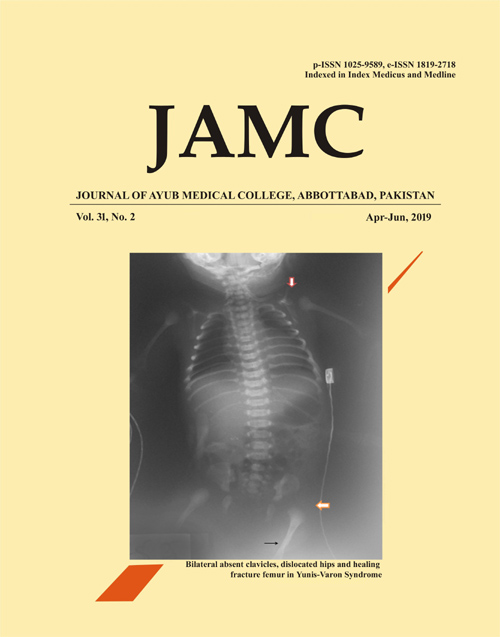FORENSIC ODONTOLOGY AND DENTAL STATUS OF ADULT PATIENTS ATTENDING THE OUT PATIENT DENTAL DEPARTMENT OF A TERTIARY CARE HOSPITAL
Abstract
Background: Pakistan is one of the countries where practice of forensic odontology and its record keeping is poor due to which we face difficulty in identification of individuals in disasters and other medicolegal problems. The objectives of this study were to know the status of forensic odontology and to determine the dental status of adult patients attending dental outpatient department of Ayub Teaching hospital Abbottabad. Methods: A cross-sectional Study was carried out from 1st September to 30th September 2018 in the Department of Dentistry, Ayub Teaching Hospital, Abbottabad. A questionnaire was designed including preliminary record, standard dental chart, notation chart and other variables. A sample of 96 patients having all permanent teeth were included and examined. Non-probability convenience sampling was used. Data was collected and analyzed on SPSS. Results: The sample consisted of 59.4% males and 40.6% females. Mean number of present teeth with sound status was 24±5. Faulty development was found in 14.6% of the patients. Faulty alignment, black/brown stains and attrition were observed in 38.5%, 86.5% and 25% of the patients respectively. No statistically significant association was found (p >0.05) between gender and faulty development, faulty alignment, staining or attrition. Forensic odontological practice and its record are not maintained in the hospital. Conclusions: High proportion the patients have black/brown stains. Faulty alignment is more as compared to faulty development. In our study we observed that no odonatological record is maintained in our hospital.Keywords: forensic odontology; identification; cross bite; overbiteReferences
Pramod JB, Marya A, Sharma V. Role of forensic odontologist in post mortem person identification. Dent Res J 2012;9(5):522–30.
Hiremath S. Textbook of Public Health Dentistry. 3rd ed. Elsevier, editor. India: Elsevier; 2016.
Ata-Ali J, Ata-Ali F. Forensic dentistry in human identification: A review of the literature. J Clin Exp Dent 2014;6(2):e162–7.
Balachander N, Babu NA, Jimson S, Priyadharsini C, Masthan KMK. Evolution of forensic odontology: An overview. J Pharm Bioallied Sci 2015;7(Suppl 1):S176–80.
Baig MZ, Siddiqi KM, Jabeen N, Israr M, Ehsan MT, Rahman F. Awareness and compliance about forensic dentistry among dental professionals of twin cities of Rawalpindi-Islamabad: A questionnaire based study. Pak Oral Dent J 2014;34(2):277–81.
Verma AK, Kumar S, Rathore S, Pandey A. Role of dental expert in forensic odontology. Natl J Maxillofac Surg 2014;5(1):2–5.
Shamim T. Forensic odontology. J Coll Physicians Surg Pak 2012;22(4):240–5.
Avon SL. Forensic odontology: the roles and responsibilities of the dentist. J Can Dent Assoc 2004;70(7):453–8.
Zahrani A. Identification of unidentified human remains validity of dental records. Pak Oral Dent J 2005;25(1):3–6.
Arif M, Qayyum R, Shaikh Q. Enhancement of Orientation of Dental Specialist in Forensic Odontology. Ann Pak Inst Med Sci 2016;12(4):244–7.
Hinchliffe J. Forensic odontology, part 4. Human bite marks. Br Dent J 2011;210(8):363–8.
Gupta S, Agnihotri A, Chandra A, Gupta OP. Contemporary practice in forensic odontology. J Oral Maxillofac Pathol 2014;18(2):244–50.
Hinchliffe J. Forensic odontology, part 1. Dental identification. Br Dent J 2011;210(5):219–24.
Awan NR. Principles and practice of forensic medicine. 1st ed. Vol. 3. Zubair Book Depot (LHR), 2009; p.169.
Albashaireh ZS, Khader YS. The prevalence and pattern of hypodontia of the permanent teeth and crown size and shape deformity affecting upper lateral incisors in a sample of Jordanian dental patients. Community Dent Health 2006;23(4):239–43.
Hassan DS, Abuaffan AH. Prevalence of Anterior Open Bite among Sample of Sudanese University Students. Enz Eng 2016;5(143):2.
Żyła T, Kawala B, Antoszewska-Smith J, Kawala M. Black stain and dental caries: a review of the literature. BioMed Res Int 2015;2015:469392.
Hegde MN, Yelapure M, Honap MN, Devadiga D. The prevalence of tooth wear and its associated risk factors in Indian South West coastal population: An epidemiological study. J Int Clin Dent Res Organ 2018;10(1):23.
Harrison M. A 4-year review of human bite injuries presenting to emergency medicine and proposed evidence-based guidelines. Injury 2009;40(8):826–30.
Devadiga A. What's the deal with dental records for practicing dentists? Importance in general and forensic dentistry. J Forensic Dent Sci 2014;6(1):9–15.
Petju M, Suteerayongprasert A, Thongpud R, Hassiri K. Importance of dental records for victim identification following the Indian Ocean tsunami disaster in Thailand. Public Health 2007;121(4):251–7.
Published
Issue
Section
License
Journal of Ayub Medical College, Abbottabad is an OPEN ACCESS JOURNAL which means that all content is FREELY available without charge to all users whether registered with the journal or not. The work published by J Ayub Med Coll Abbottabad is licensed and distributed under the creative commons License CC BY ND Attribution-NoDerivs. Material printed in this journal is OPEN to access, and are FREE for use in academic and research work with proper citation. J Ayub Med Coll Abbottabad accepts only original material for publication with the understanding that except for abstracts, no part of the data has been published or will be submitted for publication elsewhere before appearing in J Ayub Med Coll Abbottabad. The Editorial Board of J Ayub Med Coll Abbottabad makes every effort to ensure the accuracy and authenticity of material printed in J Ayub Med Coll Abbottabad. However, conclusions and statements expressed are views of the authors and do not reflect the opinion/policy of J Ayub Med Coll Abbottabad or the Editorial Board.
USERS are allowed to read, download, copy, distribute, print, search, or link to the full texts of the articles, or use them for any other lawful purpose, without asking prior permission from the publisher or the author. This is in accordance with the BOAI definition of open access.
AUTHORS retain the rights of free downloading/unlimited e-print of full text and sharing/disseminating the article without any restriction, by any means including twitter, scholarly collaboration networks such as ResearchGate, Academia.eu, and social media sites such as Twitter, LinkedIn, Google Scholar and any other professional or academic networking site.









